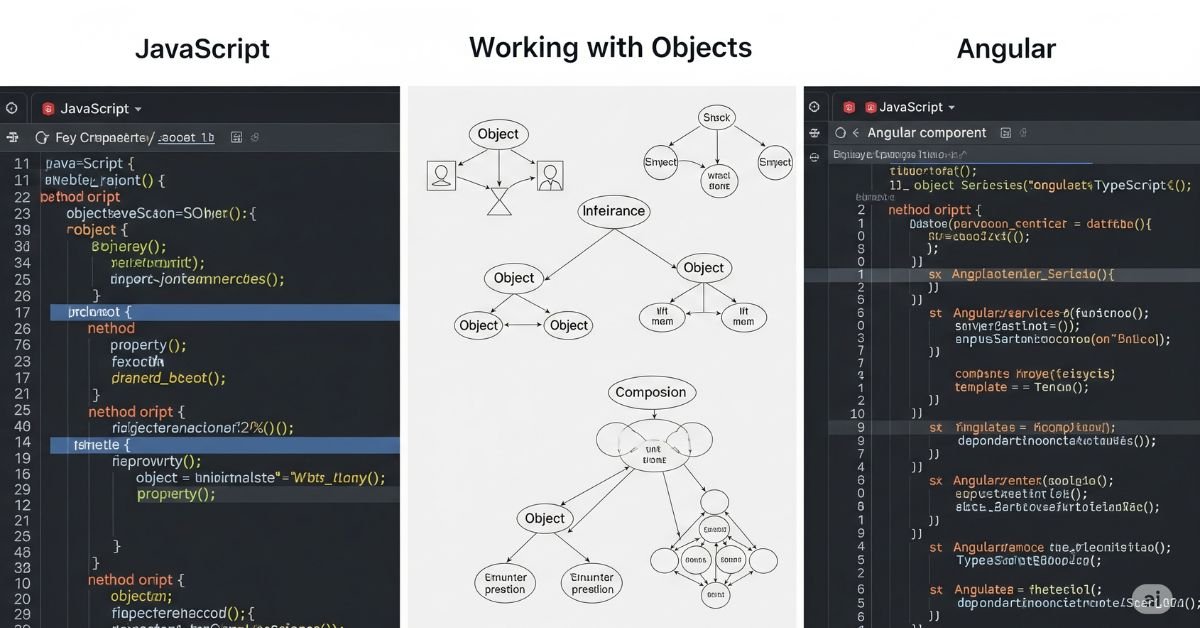If you’re jumping into something with JavaScript | Working with Objects | Angular, you’ve got to learn the ropes on using objects. They’re very useful for staying organized with your code and data. In Angular applications, objects are the ones that carry information around between services, components, and forms.
Master them, and your applications will hum along smoothly and be a breeze to work with. This guide is for programmers who want to advance from novice to pro when using JavaScript objects in Angular. We’re going to guide you through all the nitty-gritty—from the fundamentals to practical examples—using plain language, in-depth analysis, and to-the-point examples..
What Are JavaScript Objects?
Objects are the foundation of most JavaScript code. An object is a group of key-value pairs. Each key is a string, and each value can be anything—text, number, array, or even another object. In simpler words, objects help you group related data into one place. Unlike primitive values like strings or numbers, objects are reference types. That means they store the memory location, not the actual value.
This detail matters a lot when working in Angular because shared objects between components can cause bugs if not handled carefully. Objects are ideal when you need to model real-world things. For example, a user profile might include a name, age, email, and location. Using an object makes it easy to manage all of this data together.
You Will Like : Angular vs jQuery, React, and Vue.js: A Detailed Comparison for 2025
Creating JavaScript Objects
There are many ways to create objects. The most common is using object literals. For example, you write const user = { name: “John”, age: 30 }. You can also use new Object() or Object.create() methods. In Angular projects, you often define interfaces with specific types to create objects. This keeps the structure clean and easy to understand.
You can even create nested objects where one object is inside another. This is useful in real apps, like when managing form data or user settings. Here is a table to compare common object creation methods:
| Method | Syntax Example | Notes |
| Object Literal | const obj = { a: 1 } | Most common and readable |
| Constructor | const obj = new Object() | Less used in modern code |
| Object.create() | Object.create(proto) | Useful for setting prototypes |
| With Class | class User {} | Used in Angular with TypeScript |
Accessing and Updating Object Values
Once an object is created, you need to access or change its values. You can use dot notation like user. name, or bracket notation like user[“name”]. Brackets are useful when the key is dynamic or stored in a variable. If you’re unsure whether a property exists, use hasOwnProperty() or the in operator. These methods help avoid errors in templates or forms.
Modern JavaScript also offers destructuring. For example, const { name, age } = user allows you to extract values neatly. This is very handy in Angular when passing data to components.
Object Methods and the this Keyword
Objects can have functions inside them. These are called methods. For example, user.sayHello = function() { return “Hi” }. Inside a method, the this keyword refers to the object itself. But this behaves differently depending on how the function is written. Arrow functions do not bind this, while normal functions do. This causes confusion and bugs
.
In Angular, you may need to use .bind(this) when passing methods to event listeners or using timers. Understanding how this behaves is key to writing error-free code in components and services.
Looping Through Objects in JavaScript
If you need to read or update every value in an object, use loops. The for…in loop goes through each key. You can also use Object.keys(), Object.values(), or Object.entries() with forEach() to loop through objects.
In Angular templates, use the KeyValuePipe to loop through objects using *ngFor. This is especially useful when displaying user data or settings.
| Loop Type | Description |
| for…in | Loops over all keys |
| Object.keys() | Returns an array of keys |
| Object.values() | Returns an array of values |
| Object.entries() | Returns an array of key-value pairs |
Modern Features of JavaScript Objects
New versions of JavaScript have added powerful tools for working with objects. You can now use object shorthand, computed property names, and spread operators. The spread operator allows you to copy or merge objects: const newUser = { …user }.
You can also destructure objects right inside function arguments. For example, function greet({ name }) { console.log(name) }. These features help you write cleaner, shorter, and smarter code.
Using Objects in Angular Applications
In Angular, objects are everywhere. Services often return objects from API calls. Components use objects to store input or state. You also pass objects between parent and child components using @Input() or @Output().
TypeScript interfaces define the shape of these objects. This ensures that every object follows a set structure. It also helps with code completion and catching mistakes early. In Angular, well-defined objects make the app easier to test and debug.
Read More About : How to Add Angular Features to the Project
Object State Management in Angular
In large Angular apps, managing object state is critical. Services often hold object data that multiple components use. If you change the object directly, it may not trigger UI updates unless you use strategies like OnPush change detection.
RxJS helps manage object states reactively. You can use BehaviorSubjects to emit new object values and subscribe to changes. Avoid mutating objects directly. Instead, create new copies using the spread operator. This keeps your UI and data in sync.
Using Objects in Angular Templates
Templates often need to bind and display data from objects. Use dot notation like user—name to show values. For deeply nested values, use the safe navigation operator ?. to avoid errors if some data is missing.
You can also use ngIf to check if an object exists before showing it. To loop through object properties in a template, apply the KeyValuePipe with *ngFor.
Common Object Mistakes in Angular
A few mistakes happen often when using objects in Angular. One is mutating shared objects inside components. This causes bugs because Angular may not detect the changes. Another issue is not typing your objects with interfaces. This makes code harder to read and test.
Also, avoid deeply nested objects without a clear structure. It leads to performance issues and hard-to-find errors. Finally, remember that object comparison uses references, not values. Always clone objects if needed.
Best Practices for Object Handling in Angular
Always define object types using TypeScript interfaces. This helps your team understand what each object should contain. Avoid direct mutation—use immutable patterns instead. It’s safer and easier to manage.
Separate UI logic from data logic. Use models and helper functions to handle object data. Also, provide fallback values for properties that might be missing to avoid undefined errors.
Practical Object Examples in Angular
In real Angular apps, you use objects for form data, HTTP requests, and shared services. For example, a login form may use an object like { email, password }. When the user submits it, the object is sent to an API.
Angular’s reactive forms also store form controls in an object. This makes it easier to manage multiple fields. Here’s an example of a login object:
| Field | Type | Example Value |
| string | “user@mail.com” | |
| password | string | “abc123” |
| remember | boolean | true |
Case Study: Managing User Profiles in Angular
Imagine you are building a user profile page. You fetch user data from an API and store it in an object. This object includes name, email, age, and preferences. You use @Input() to pass the profile to a child component.
To update the profile, you use reactive forms. When the user changes a field, you update a copy of the profile object. Then you send the new object to the server. This flow is clean and avoids bugs. It also makes it easy to track changes.
Debugging and Testing Object Data
To debug object data, use console.log() or console.table(). This helps you see the structure of the object. Chrome DevTools also lets you inspect objects in real time.
In tests, mock objects can simulate real API responses. Use Jasmine to check object values in services or components. When testing forms, make sure object values are updated correctly after user input.
FAQ” S
Why are objects so important in Angular?
Because they store and manage structured data used in forms, services, and components.
Can I pass an object to a component in Angular?
Yes, use @Input() to send objects from parent to child components.
What is the best way to clone an object in Angular?
Use the spread operator … or Object.assign() for shallow copies.
How do I loop through an object in an Angular template?
Use KeyValuePipe with *ngFor to access key-value pairs.
What happens if I mutate an object in Angular directly?
The UI may not update because Angular tracks references, not values.
Conclusion
Understanding how to use JavaScript | Working with Objects | Angular is one of the most important skills in web development. It helps you write clean, reusable, and efficient code. Whether you’re building forms, handling API data, or managing shared state, objects are at the core of every Angular app. Practice the techniques, follow best practices, and avoid common mistakes to level up your skills.





When some one searches for his required thing, thus he/she wants to be available
that in detail, therefore that thing is maintained over here.
Magnificent goods from you, man. I have take into
accout your stuff previous to and you’re just too wonderful.
I really like what you’ve obtained here, certainly like what you are stating and the best way through which you
assert it. You are making it enjoyable and you continue
to care for to keep it smart. I can’t wait
to learn far more from you. This is really a tremendous
website.
I think this is one of the most vital info for me. Annd i
am glad reading your article. Butt should remark on few general things, The wweb site style is
perfect, the articles is really nice : D. Good job, cheers
Excellent submit, very informative. I ponder why the other experts of this sector don’t realize this. You should continue your writing. I’m confident, you have a huge readers’ base already!
I do consider all of the ideas you’ve presented on your post. They are very convincing and can certainly work. Nonetheless, the posts are too quick for starters. May just you please extend them a little from next time? Thanks for the post.
Okay! Thanks, have a nice day
Pretty section of content. I just stumbled upon your website and in accession capital to assert that I acquire actually enjoyed account your blog posts. Anyway I’ll be subscribing to your augment and even I achievement you access consistently quickly.
Thank you
I was suggested this web site by my cousin. I am not sure whether this post is written by him as nobody else know such detailed about my difficulty. You’re incredible! Thanks!
Thank you!
Its like you learn my thoughts! You seem to understand so much about this, such as you wrote the guide in it or
something. I feel that you just can do with some percent to drive the message house a little bit, but other than that, this is magnificent blog.
A fantastic read. I’ll certainly be back.
Thank you!
It’s perfect time to make a few plans for the long run and
it’s time to be happy. I’ve learn this post and if I may I desire to counsel you few attention-grabbing things or suggestions.
Maybe you can write next articles relating to this article.
I wish to learn more issues about it!
Thanks! Yes, we are writing blogs on daily basis!
Ahaa, its good discussion about this paragraph at this place at this blog, I have read all that, so now me also commenting at this place.